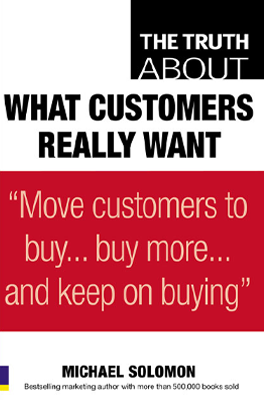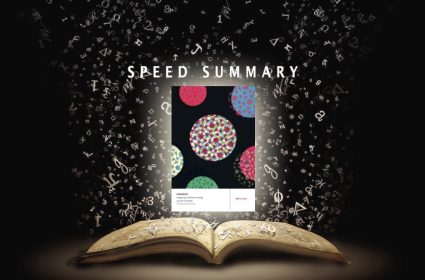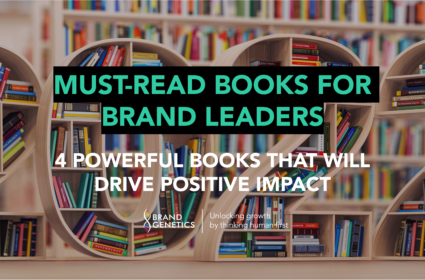The Truth About What Customers Want

 The Truth About What Customers Want
The Truth About What Customers Want- Author: Michael Solomon
- Publisher: FT Press
- Publication: 2009
Marketing is about satisfying needs, but in order to do that you need to understand needs. To help busy marketers, Dr Michael Solomon, consumer psychologist and author the leading textbook on consumer psychology; Consumer Behaviour: Buying, Having and Being, has distilled down the discipline into 50 short chapters covering 50 basic truths about what customers want.
And here’s the distillation of the distillation – 50 bite-sized truths about what customers want: The first 25 now, second 25 to follow in the next post
1. Your customers want a relationship, not a one night stand – Apple beat Sony in the portable music business because it sells a service not a product – the player is just a means to sell the iTunes service, not an end in itself. Mutually beneficial relationships trump technological prowess every time
2. Design it, and they will come – Customers want good design: Good design trumps quality, form is function. The “first moment of truth” is when you win the heart of the consumer – and looks are what counts. So, like the design-led Method house-cleaning products that woke P&G up to the importance of design – make design your competitive advantage
3. Sensory marketing – smells like profit – Customers want a sensory experience. We use our senses to make sense of the world. Fragrances cue emotional associations and are processed in the limbic system, the primitive – powerful and automatic – part of the brain. Fresh coffee creates warm and safe associations of home and is used in scent marketing – which is why you’ll find coffee concessions in banks. So market to people’s senses not to their sense
4. Pardon me, is that a breast in your Coke? – Customers want to keep it above board. You can try subliminal ads – where minds process stimuli below the threshold (limen) of awareness – like the hidden form of a nude woman in a glass of Coke – but if you get caught out expect a backlash. Unfortunately, or fortunately, there is no evidence that subliminal ads work – so invest elsewhere.
5. One man’s goose… – Customers want an experience that fits their personal interpretative framework. People don’t experience reality, they interpret it – and they do so depending on their personal interpretative frameworks. Two people may be exposed to the same stimulus, but ‘see’ something completely different. And because interpretations are based on the associations we make, associations can influence perception. Which is why kids find fries in a McDonald’s bag more tasty than the same fries in a white bag. Put carrots in a McDonald’s bag, and they’ll prefer those too. Bottom line, to understand reactions, you need to understand interpretations – it’s not the experience, it’s the interpretation of the experience that counts
6. Throw ’em a bone and they’ll not longer roam – Customers want positive reinforcement. Behavioural learning (conditioning) works. Reinforce a brand choice with a positive experience, and they’ll come back. But conditioning can be more subtle – reinforce a brand choice positively with a compliment on their good taste, and they’ll choose it again. And because people respond to similar stimuli similarly, you can hijack stimulus-response pairings from other brands – like a copycat brand, or a sub-brand benefiting from a ‘halo effect’ of the conditioned responses to the original/lead brand
7. Stay in their minds – if you can – Customers want what is familiar. We like what we know – familiarity, far from breeding contempt, promotes affinity – an insight upon which the advertising industry is built. So salience matters – being ‘top of mind’ in the mind of the customer. To achieve salience, you need attention; the more we pay attention to stimuli, the more salient the memory, the easier the recall, the more familiar the product appears, the more we like it, and the more we’re likely to choose it.
8. These are the good old days – Customers want nostalgia. Through memories, people live in, are influenced and even defined by the past. Nostalgia is the bittersweet emotion associating past memories – real or imagined – with sadness and longing; so use nostalgia marketing to associate your brand with warm memories of the past. Use music or cinematic cues (our favourite music is the music that played between 23-24 birthdays, and our favourite films were those screening when they were 26-27), as well as product cues from our lost youth
9. Why ask why? – Customers want to live by their values. People are motivated by outcomes, but also by values. Sometimes a chain of ‘why?’ questions smartly posed can lead you up the motivational ladder to core values and their corresponding core needs (need for achievement (value of accomplishment), affiliation, power, and uniqueness), but most often consumers cannot articulate what really motivates them – or their needs. You can use psychological research into motivations and needs (but bin the outdated and unproven Maslow’s Hierarchy of Needs); the key thing to remember is people have multiple needs and need priorities – your product should address a need priority, not just a need
10. He who dies with the most toys wins – Customers want what their [sub]culture wants. People are defined by their culture and sub-culture as much as their personalities and personal experiences, so understand the core (sub)cultural values of your consumers. In the US, materialism, freedom and achievement are core cultural values; marketing based on this broad cultural ‘outsight’ may be more effective than any ‘insight’ into specific customer groups
11. Your customers are looking for greener pastures – Customers want to be greenwashed. Consumers bemoan corporate greenwashing, but they’re usually up for a bit of personal greenwashing – so they look and feel as planet conscious as they are body conscious. Cue L’Oreal’s purchase of the Body Shop, H&M and Gap clothes in organic cotton, P&G sustainable packaging. There’s even a new term for this green consumer – LOHAS – lifestyles of health and sustainability – driven by a merging interest in personal health and global health. Sell more by showing your customers how your products help them reduce their carbon footprint – and call it conscientious consumerism
12. Because I’m worth it – Customers want it, and they want it now. People have a quite irrational belief that they deserve good things, and an equally irrational desire to want them now. Play to people’s over inflated opinions of themselves, and to their compromised ability for deferred gratification. Sell to the me generation, who want it now. And for those with self-esteem issues, use social comparison to show how better they’ll look, feel and be if they use your product by using self-esteem marketing and aspirational models
13. Love me, love my avatar – Customers want a digital self. So Second Life tanked, but virtual reality will be the next big marketing platform, from augmented reality apps on our handsets to immersive experiences in virtual worlds. As the digital world takes an ever bigger slice of our existence, our online personas – which are often more honest and truthful – increasingly define us. Consider how you might harness the digital consumer, and blur the lines between physical and digital reality
14. You really are what you wear – Customers want to construct (and signal) an identity. Identity marketing is not a fad, it taps into the social nature of human beings, we define ourselves based on how we project ourselves to others; our identity, our extended self, is a reflection of the image we signal to others through badging with products and brands we use. Think of your product not as an object or service but a badge used for bricolage identity construction
15. Real men don’t eat quiche (but they do moisturise) – Customers want to construct (and signal) a sexual identity. Sexual identity is an important component of a consumer’s self-concept, but don’t be a reductionist. Selling pink to girls and speed to boys won’t work in an age of fluid sexual identity – the rise of the metrosexual (body and fashion conscious men who do cosmetics), the retrosexual backlash, sexual ambiguity, and lipstick lesbianism. There’s a limit to the utility in labelling people rather than products – but know that people define themselves – and the products they choose, can be heavily influenced by their sexual identity
16. Girls just want to have fun – Female customers want power, speed and tech as much as men. 75% of consumer electronics purchasing decision involve women, ads work better when women models look empowered, and the speed-freak car tuning industry is 25% powered by women’s purchases. Smart marketers have figured out that the fun-seeking, tech savvy empowered female consumer is a smart target
17. Queer eye for the spending guy – GLTB customers want to signal their identity. 6% of consumers identify themselves as GLBT (gay, lesbian, bisexual or transgendered) – more than most ethnic markets. They have money, specialised media and take signalling their identity seriously. More reasons to take (sexual) identity marketing seriously.
18. Yesterday’s chubby is today’s voluptuous – Fat customers want to be liked. Slim, slender and size 0 still rules, but there’s a backlash – and as ever more people get ever fatter – the fat market is big, and has big self-image issues. How could you, like Unilever’s ‘Real Beauty’ Dove campaign help fat people feel better about themselves. You’re not chubby, you’re voluptuous
19. Men want to sleep with their cars – Customers want perennial stories. There may be few card-carrying Freudian or Jungian psychologists left, but the idea that products can have deep meanings for people, and that they can become deeply attached to those products is an enduring insight. It can be useful to think of cars as sexual surrogates, and good products/ads as personifications of ‘archetypal’ characters and narratives. You don’t have to buy into the psychobabble to get the utility.
20. Your PC is trying to kill you – Customers want to personify. People personify objects, giving them personalities and even motivations. As social creatures our minds our wired to think in terms of people not things – which is why good branding involves personifying a brand beyond the stamp of credibility and trustworthiness that a trademark offers. A smart brand is a person, not a trademark
21. Birds of a feather buy together – Customers want to belong. Target shared lifestyles, not individual people. The AIO of lifestyle marketing – activities, interests and opinions – begins with activities, so you should too, whether its online behavioural marketing (marketing based on browsing activity), or market segmentation based on shared activities (as opposed to demographics or opinions). Identity construction is as much about what we do, as what we think and say.
22. Sell wine spritzers to squash players – Customers want to role-play. More on lifestyle marketing – look for common patterns of behaviour and social situations associated with a lifestyle – and target those not people. Like consumers, marketers make a fundamental error in attributing behaviour to individuals rather than roles and contexts – it’s called the Fundamental Attribution Error. Think contexts (situations) and roles (behaviour patterns) and target those.
23. They think your product sucks, but that’s not a bad thing – Customers want to talk. And they do talk – increasingly online. Just as your reputation is what people say about you when you leave the room, your brand is not what you say about yourself, it’s what other people say about you. But that’s a good thing – your brand is more about what you do, than what you say. So put some of that advertising self-puffery budget to a couple of good uses – activating your word of mouth promoters, and address the concerns of your detractors
24. When to sell the steak, when to sell the sizzle – Customers want the easy option. When consumers don’t particularly care about a product (so-called low-involvement products), they’ll use what is know as peripheral processing to decide, taking extrinsic cues for both the product (how it’s packaged, designed), and how it’s advertised (how it’s presented, who it’s endorsed by vs. the message). The contrary is only true for products consumers really care about, we process information ‘centrally’ – meaning we consider arguments and facts (as opposed to ‘peripheral’ persuasion which uses extrinsic cues)
25. People are dumber than robots (lazier too). Customers want to avoid having to think. Consumer behaviour is often irrational, that is, people make consistently poor choices that at best are not in their best interest and at worst are self-harming. This is because we are cognitive misers – or lazy thinkers, using readymade rules of thumb, contextual and flawed mental accounting to make decisions rather than applying rational thought. So understand how people actually make decisions in situ rather than how they should.




